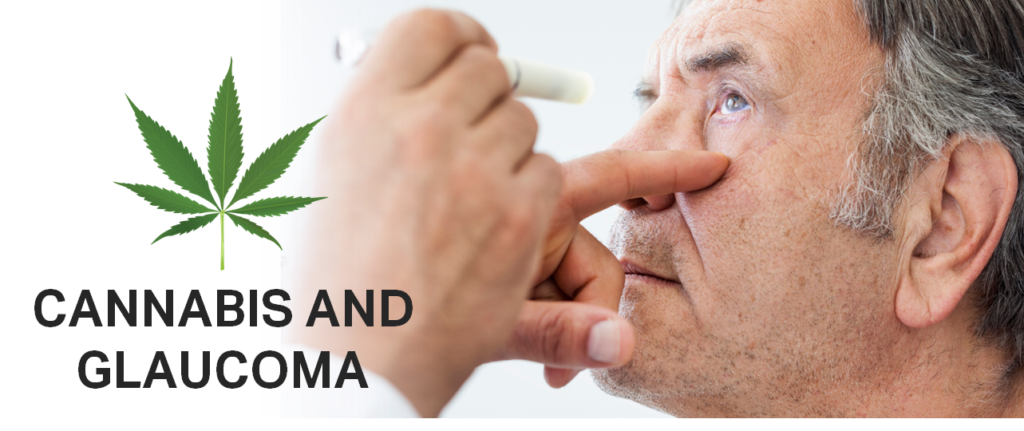Cannabis was identified as having positive effects in the treatment of glaucoma in 1971 when researchers published the results of a study in the Journal of the American Medical Association that found a decrease in eye pressure of 30% for study participants after they smoked marijuana. Today, numerous states have approved glaucoma as a qualifying condition for medical cannabis.
What is Glaucoma?
Glaucoma is an eye disease that can damage the optic nerve and cause long-term vision loss or blindness if left untreated. For people with glaucoma, the optic nerve in one or both eyes, which carries information from the eyes to the brain, is damaged by fluid buildup in the eye that cannot drain out. The buildup of fluid causes eye pressure which leads to the slow progression toward blindness.
In the past several decades, numerous drugs and surgeries have been introduced to treat glaucoma patients and slow the progression toward blindness by reducing intraocular eye pressure. However, glaucoma is still the second leading cause of blindness in the United States behind cataracts (first for African Americans in the United States), and it affects approximately 60 million people. One percent of people over the age of 60 have glaucoma, and more than 9% of people over the age of 80 develop the disease.
Researchers have identified three primary risk factors for glaucoma: age, race, and elevated intraocular eye pressure. The only one of these factors that can be controlled is eye pressure – primarily through the use of medication or surgery.
How Does Cannabis Help Glaucoma Patients?
The drugs that have been developed and approved to treat glaucoma by the Food and Drug Administration (FDA) can be very effective, but they’re not guaranteed to work. Some patients have problems finding a medication that effectively reduces their eye pressure.
For many glaucoma patients, cannabis provides another way to support their doctor-recommended treatment plan – particularly those with end-stage glaucoma who also need to manage related anxiety or depression.
According to research published by the U.S. Library of Medicine, several studies have found that cannabis administered orally (smoked, eaten, or ingested in pill form), intravenously, or through inhalation reduces eye pressure as well as conventional glaucoma medications. It has been discovered that a single dose of cannabis reduces intraocular eye pressure for three to four hours, but taking larger doses will not lengthen the duration of the effect.
Specifically, research funded by the National Eye Institute (a division of the National Institutes of Health) found that smoking cannabis or taking tetrahydrocannabinol (THC) by pill or injection temporarily reduces eye pressure. However, the researchers also discovered that the effects only last for three to four hours.
A separate study published in the Journal of the American Medical Association – Opthamology found that cannabis reduces intraocular eye pressure by an average of 25% in 60-65% of people with or without glaucoma.
Based on the research conducted to date, it is clear that cannabis can be used to lower intraocular eye pressure. However, there are some drawbacks to consider. First, glaucoma patients must maintain lowered levels of eye pressure 24 hours a day. Since cannabis is only effective in reducing eye pressure for three to four hours, patients need to take it repeatedly throughout the day. For some people, this isn’t realistic, and for others, the cost is too high.
Second, many patients don’t like the mood-altering effects of cannabis, and third, cannabis can cause other side effects like reduced blood pressure and tachycardia that could negate the benefits for glaucoma patients using it to reduce eye pressure.
For patients who do want to support their glaucoma treatment with cannabis, they should consult with their doctors first. If their doctors agree that cannabis would be helpful, patients should work closely with their dispensary budtenders to choose the right strain, dosage, and administration methods so they get the desired effects they want without the side effects they don’t want.
More Research about Cannabis and Glaucoma is Needed
Studies have found there are receptors for the active ingredients of marijuana in eye tissues, and research has suggested that administering the active ingredients of cannabis may have multiple neuroprotective effects. However, available research is still very limited.
The American Academy of Ophthalmology’s Complementary Therapy Task Force released a statement in 2009 and 2014 that said, “No scientific evidence has been found that demonstrates increased benefit and/or diminished risk in the treatment of glaucoma compared with the wide variety of pharmaceutical agents now available.”
Furthermore, the American Glaucoma Society has a similar position saying there is a need for, “A well-tolerated formulation … with a much longer duration of action shown in rigorous clinical testing to reduce damage to the optic nerve and preserve vision.”
Bottom-line, there have been no studies to date that compare cannabis with other treatments for glaucoma. Medical professionals have a lot of strong evidence showing that conventional treatments and medications work, but they don’t have the same information for cannabis treatments.
That is one of the reasons why the Glaucoma Research Foundation has called for, “A long-term clinical trial that evaluates the health of the optic nerve as well as eye pressure,” to determine if cannabis can be recommended as a treatment method for the disease.
Patients and doctors need all of the facts to make the most informed healthcare decisions, and the critical need for more research about cannabis and glaucoma cannot be stressed enough today.

